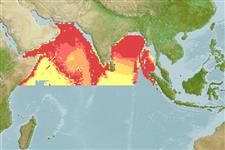Teleostei (teleosts) >
Acropomatiformes (Oceanic basses) >
Bathyclupeidae (Deepsea herring)
Etymology: Bathyclupea: Greek, bathys = deep + Latin, clupea = sardine. See under "clupea" (Ref. 45335).
More on author: Alcock.
Environment: milieu / climate zone / depth range / distribution range
Ecology
Marine; pelagic-oceanic; depth range 330 - 550 m (Ref. 122568). Deep-water
Indian Ocean: Arabian-Bengal province..
Size / Weight / Age
Maturity: Lm ? range ? - ? cm
Max length : 19.0 cm TL male/unsexed; (Ref. 126025); max. published weight: 76.00 g (Ref. 126025)
Short description
Identification keys | Morphology | Morphometrics
This species is distinguished by the following characters: head length (2.8) 2.9-3.1 times in SL; maximum body height 27.8-33.3% SL, usually more than 29%; preanal length 39.8-48.0% SL (usuially less than 45%); anal fin with 30-33 (usually 32-33) rays; developed gill rakers on first arch 27-30, the longest gill rakers 11.9-15.1% of head length; denticles on ventral branches of praeoperculum somewhat weaker than in two other species; 5 (very rarely 4) axonosts of anal fin before first hemapophysis; edges of pectoral fins distinctly blackish (Ref. 122568).
Needs better reference. Andaman Sea, 11°31'40"N, 92°46'40"E, Investigator station 115, 188-220 fathoms.
Life cycle and mating behavior
Maturities | Reproduction | Spawnings | Egg(s) | Fecundities | Larvae
Prokofiev, A.M., 2014. Taxonomy and distribution of deepsea herring (Bathyclupeidae) in oceans. J. Ichthyol. 54 (8):493-500. (Ref. 122568)
IUCN Red List Status (Ref. 130435)
Threat to humans
Harmless
Human uses
Tools
Special reports
Download XML
Internet sources
Estimates based on models
Preferred temperature (Ref.
123201): 10.6 - 12.8, mean 10.7 °C (based on 5 cells).
Phylogenetic diversity index (Ref.
82804): PD
50 = 0.5156 [Uniqueness, from 0.5 = low to 2.0 = high].
Bayesian length-weight: a=0.00389 (0.00180 - 0.00842), b=3.12 (2.94 - 3.30), in cm total length, based on all LWR estimates for this body shape (Ref.
93245).
Trophic level (Ref.
69278): 3.5 ±0.5 se; based on size and trophs of closest relatives
Fishing Vulnerability (Ref.
59153): Low vulnerability (10 of 100).
